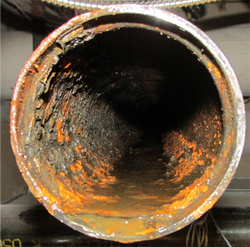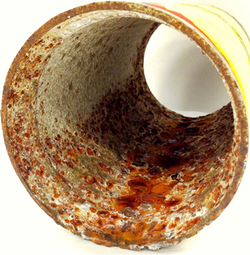All About Corrosion
Why Use Nitrogen?

The interior of preaction and dry sprinkler piping is subject to corrosion, which can lead to clogged sprinkler heads, leaks, and pipe failure. This corrosion can be of two distinct types. Oxidation corrosion takes place in the presence of oxygen, and is accelerated by the presence of water. Microbiologically influenced corrosion (MIC) takes place in the presence of certain microbes that attack metal, again in the presence of water and in many cases oxygen. Reducing the damaging effects of this corrosion is best accomplished by greatly reducing or eliminating the amount of water and oxygen left in the pipe. Ordinary air compressors that are used to provide supervisory pressure keep the oxygen concentration inside the pipe the same as normal air – ideal for oxidation corrosion to take place. Ordinary compressors also do not dry the air – residual water system testing remains in low points, and moist air can actually increase standing water within pipes from condensation. The introduction of high-purity dry nitrogen with a low dew point reduces or eliminates these two problems. The interior of the pipe remains dry, with very little oxygen remaining to attack the metal.
Articles on Corrosion
 Section of pipe removed from preaction sprinkler, showing overall internal corrosion, accelerated corrosion at bottom from standing water, and edge corrosion from improper coupling groove placement. Not shown – pinhole leak in area of accelerated corrosion.
Section of pipe removed from preaction sprinkler, showing overall internal corrosion, accelerated corrosion at bottom from standing water, and edge corrosion from improper coupling groove placement. Not shown – pinhole leak in area of accelerated corrosion.
To learn more about corrosion in general, click on the links below…
- Engineer’s Guide to Corrosion: Part 1
- Engineer’s Guide to Corrosion: Part 2
- Engineer’s Guide to Corrosion: Part 3
- Loss Prevention Data Sheet 2-1 – Corrosion in Automatic Sprinkler Systems – FM Global Oct 2016
- Technical Report – Corrosion and Mitigation in Fire Systems – FM Research Jul 2014
- Paper – Anaerobic MIC – Fact or Fiction
- Article – Avoiding Corrosion in Sprinkler Systems – Plumbing Systems and Design Aug 2006
- Technical Report – Results of Long-Term Corrosion Testing – NACE 2013 No. 2846
NITROGEN-PAC Links
- NITROGEN-PAC Home
- NITROGEN-PAC SC Series
- NITROGEN-PAC M Series
- Equipment Selection Guides
- True Advanced Purge (TAP)